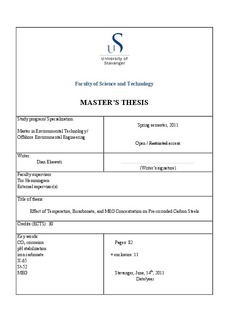| dc.contributor.author | Ekawati, Dian | |
| dc.date.accessioned | 2011-10-04T14:30:48Z | |
| dc.date.available | 2011-10-04T14:30:48Z | |
| dc.date.issued | 2011 | |
| dc.identifier.uri | http://hdl.handle.net/11250/182470 | |
| dc.description | Master's thesis in Environmental technology | en_US |
| dc.description.abstract | CO2 corrosion in carbon steel has been a major problem in many of oil and gas fields for years. One method that has been known to be effective for corrosion control especially in pipeline is pH stabilization. This method is often combined with MEG injection for hydrate prevention. pH stabilization utilizes chemical, mostly bases for adjusting pH to an optimum value that encourages protective FeCO3 formation. This master thesis project is aimed to find the effect of MEG concentration, bicarbonate, temperature, and steel type on CO2 corrosion of pre-corroded steel. The addition of MEG ranged between 0-50% wt, while bicarbonate concentration was between 0-100 mmol/kg. Experiments were performed on pre-corroded X-65 and St-52 steel by applying anodic current of 0.25 mA/cm2 for 24 hours, at temperature 20oC and 40oC. Effect of those parameters on the corrosion reactions was characterized by iron concentration, Rp/Ec trend, and potentiodynamic polarization measurements.
The results from the experiments showed a decrease in corrosion rate with the increase in MEG and HCO3- concentration. These effects were observed in Rp/Ec trend and potentiodynamic sweep. Temperature on the other hand increased the corrosion rate, except under conditions where protective iron carbonate film was most likely formed. Some indication of FeCO3 formation and steel passivation were detected in 100 mmol/kg HCO3-, 50% MEG, and 40oC in both steels. Only at this condition pitting was observed, while the other conditions showed uniform corrosion. The corrosion rate was found to be higher than 1 mm/y in case of uniform corrosion, in which St-52 attained higher corrosion rate compared to X-65 due to higher carbon content. Under formation of protective FeCO3 film, the corrosion rate decreased to 0.34 and 0.24 mm/y for X-65 and St-52 respectively. | en_US |
| dc.language.iso | eng | en_US |
| dc.publisher | University of Stavanger, Norway | en_US |
| dc.relation.ispartofseries | Masteroppgave/UIS-TN-IMN/2011; | |
| dc.subject | teknisk miljøvern | en_US |
| dc.subject | offshore teknologi | en_US |
| dc.subject | CO2 corrosion | en_US |
| dc.subject | pH stabilization | en_US |
| dc.subject | iron carbonate | en_US |
| dc.subject | X-65 | en_US |
| dc.subject | St-52 | en_US |
| dc.subject | MEG | en_US |
| dc.title | Effect of temperature, bicarbonate, and MEG concentration on pre-corroded carbon steels | en_US |
| dc.type | Master thesis | en_US |
| dc.subject.nsi | VDP::Technology: 500::Marine technology: 580::Offshore technology: 581 | en_US |
| dc.subject.nsi | VDP::Technology: 500::Marine technology: 580::Offshore technology: 581 | en_US |
